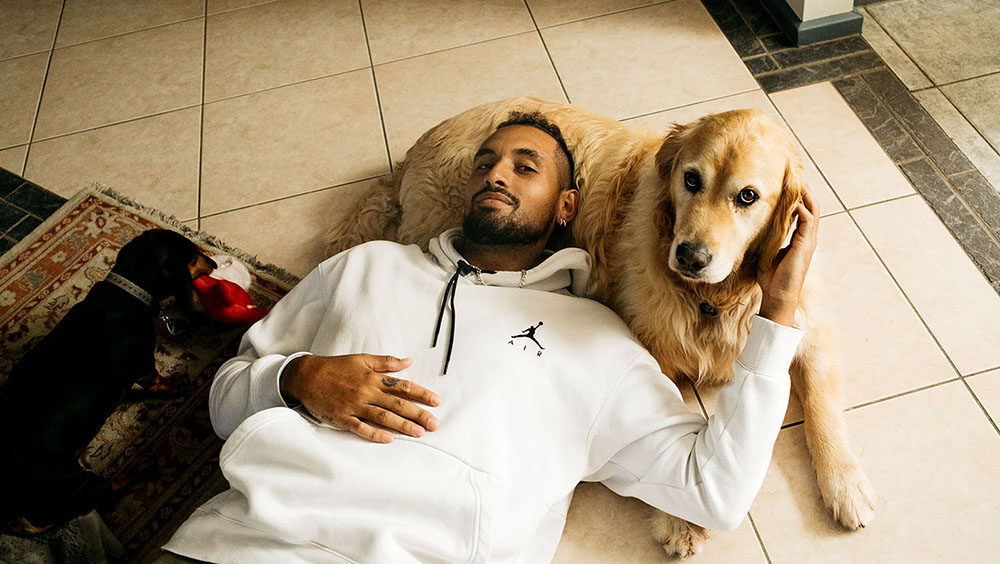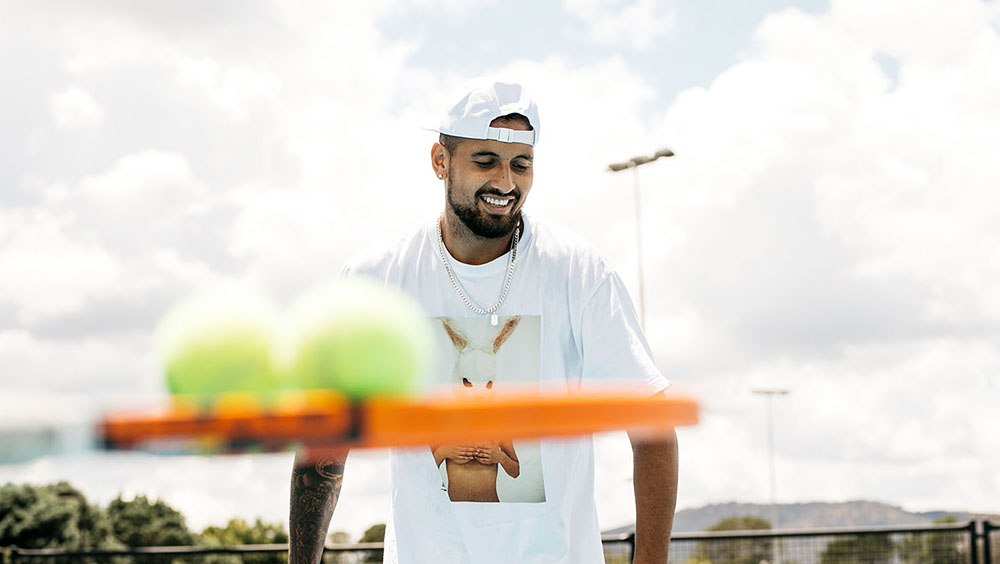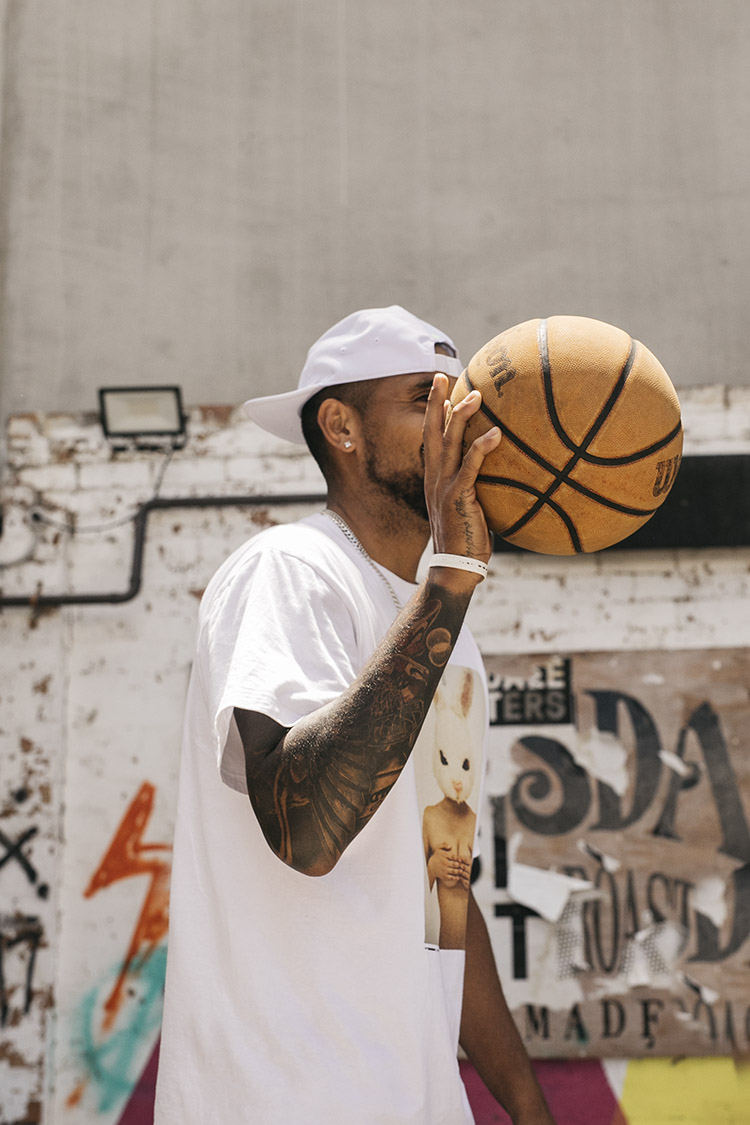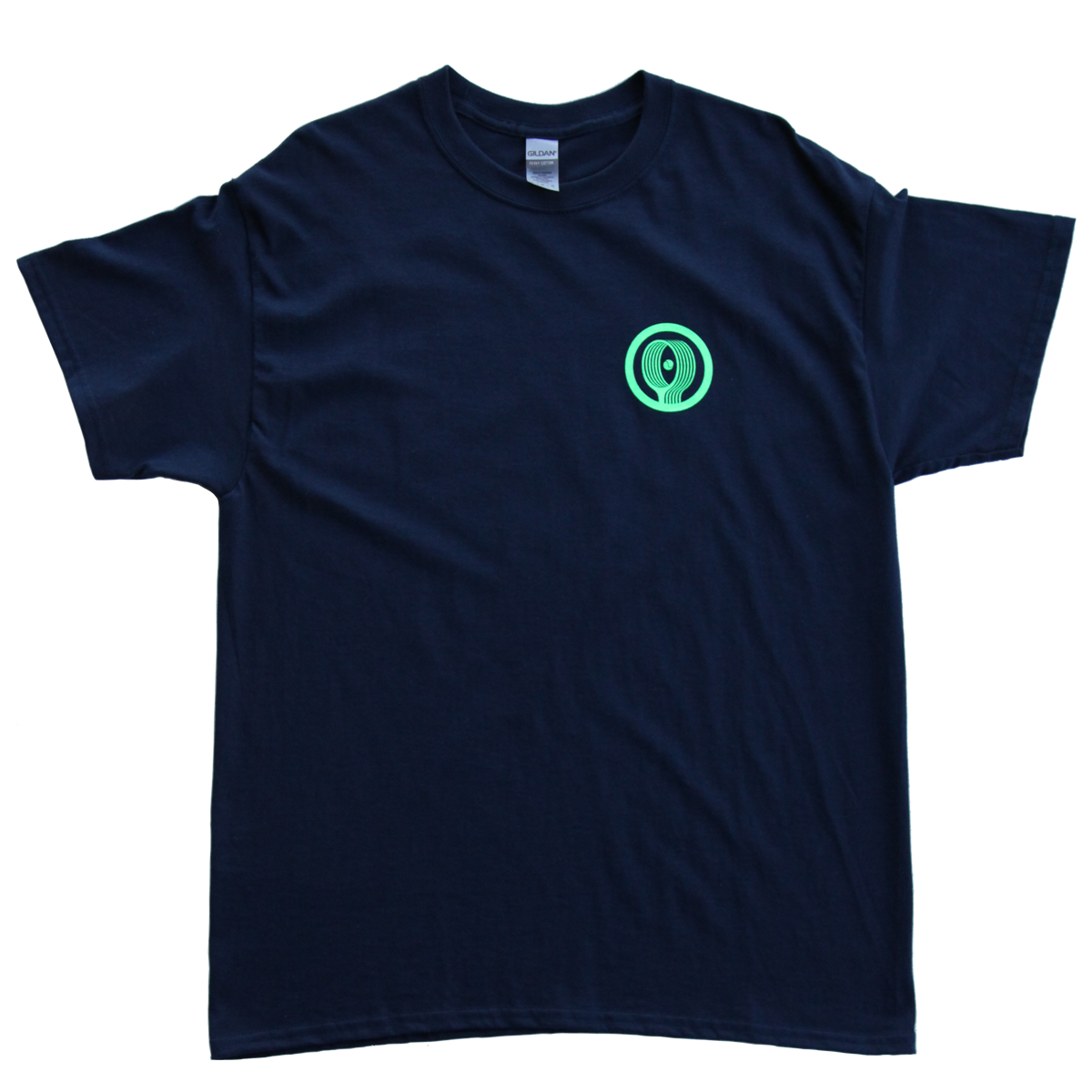By Giri Nathan
Photographs by Abigail Varney
Nick Kyrgios’ Year of Rest, Relaxation, and Reason.
Every hero is situational. I don’t mean that to diminish them. But every hero needs a little dumb luck, a neat alignment of their special qualities and the exigencies of the moment. In 2020, as a pandemic ate the world, tennis needed a hero who checked off a number of key criteria. This hero must not be hell-bent on traveling for and competing in competitive tennis matches during a public health crisis. Indeed, this hero should be able to pledge allegiance, without hesitation, to the couch, the controller, the two dogs. The hero also had to have a platform befitting a top tennis player, but none of the smoothed-over stump-speech civility that usually characterizes those players. The hero must have a dogged commitment to posting online—rudeness is a plus. The hero must have a history of acting somewhat stupidly and thus some desire to look good against the backdrop of peers acting far more flagrantly and consequentially stupid. And so it came to be that Nick Kyrgios was the hero tennis needed in 2020. He’s been looking for an excuse to Stay At Home his whole career, and a novel coronavirus asked him to do exactly that. His long-lived disinterest, in this new context, became sagacity.
So the best season Nick Kyrgios ever had was one in which he played nine matches, tucked away the racquets in February, and spent the rest of the year patrolling the timeline. As tennis players did dumb things, over and over, the voice cutting through the din had a familiar Aussie twang. Tennis’ watchdog did not miss a single misstep. Just review the evidence. When Novak Djokovic organized his ill-fated international exhibition tournament over the summer, Kyrgios called it “boneheaded.” The indelible image from that event is the gaggle of ATP players gyrating shirtless on a stage in a crowded Belgrade nightclub; the event went on to produce a cluster of positive COVID-19 cases, including Djokovic himself. Kyrgios described the bunch as “partying like potato’s [sic] during a global pandemic.” Sascha Zverev, one of the shirtless gyrators in question, issued a boilerplate promise to self-isolate for two weeks after this exposure to confirmed cases…only to be spotted six days later, on the Instagram account of a German fashion designer, partying at a club in the French Riviera. Here again was Kyrgios, filming an extemporaneous riff while driving his car, asking, “How selfish can you be?” Predictably, the tennis players began to close rank. Fellow potato Borna Coric questioned Nick’s qualifications for judging conduct—as if chewing out umpires holds the same moral weight as potentially pumping a dance floor full of coronavirus—and Kyrgios asked about his “peanut of a brain.” When Boris Becker emerged from a broom closet to chastise Nick for daring to criticize other tennis players, he too was met with devastating force (called a “donut”). There are only so many saints canonized for their strongly worded tweets. But for many sane fans, there was catharsis in seeing a tennis player trying to hold his colleagues accountable.
Then came the Australian Open, on his home turf. As hundreds of players and staff descended on Melbourne, they were placed in hotel rooms to quarantine. Many players were dissatisfied by the digs, for reasons ranging from food to mice. Djokovic passed an ambitious list of requests for improved accommodations on to tournament director Craig Tiley; Kyrgios, who read this as a demand for special treatment, called the Serbian a “tool.” While he will admittedly leap at any chance to troll this man—he later walked out into an empty stadium, for a doubles match, imitating Djokovic’s bosomy post-match celebration—Kyrgios has reason to be sensitive here. As a result of some of the most stringent lockdowns in the world, Australia had almost eradicated active COVID-19 cases, and had been living mask-free for months. Kyrgios relishes this hard-won normality, understands the sacrifices required to bring it about, and didn’t like seeing those safety measures questioned by outsiders. With elderly people in his life, and a mother who is sick, he took it personally. That was the through-line as he spoke to me on a jittery Zoom, from the lot behind a coffee wholesaler in his hometown of Canberra. There’s a basketball hoop there. He likes to go there to clear his head. On that particular day it was a “stinking hot” 40 degrees, per his agent, and Nick was in the thick of that annual flurry of pre-Open press that does not seem to scale up or down with his world ranking. Nobody frets about whether you’re seeded this year so long as you’re one of the only living humans who can both give an entertaining quote and give Rafa a scare.
“Tennis players in general are very selfish. Most of the players have been handed things on a plate their whole life. They think they’re the be- and end-all, they think that everything revolves around tennis,” Nick told me. And maybe he’s onto something. Even among pro athletes, the tennis player has been most rigorously groomed for an entire lifetime to excel at this one task, an individual conquest over another individual. “And you can see that the number-one player in the world was partying while people were losing their lives; now he’s coming to Australia and making demands. Tennis is not the only thing that exists, you know? Honestly, at times I felt ashamed to be part of the tennis community because of how we went about it.” Shame, an emotion I don’t readily associate with our hero, became the theme of our chat about tennis and the pandemic. Nick doesn’t relate to the priorities of his co-workers. He sees himself as different from the other blinkered strivers, an everyman with unspectacular values. He suspects this is why fans tend to relate to him, despite his ability to hit 140-mph aces. And there absolutely are elements of the everyman in his life: He gets much of the meaning in his life outside his job, he’s occasionally unwilling to perform at the office, and he’s grateful for any time off.

He can’t really be blamed for wanting to kick back. For all its restrictions, life in lockdown was in many respects more “normal” than his real life as an internationally touring tennis player, when waking up in the same house every day is not something to be taken for granted. Most days, Kyrgios told me, he got out of bed, didn’t touch a racquet, and lounged around the house with his family and two dogs, the dachshund Quincy and golden retriever King. He ate clean and well. He got a girlfriend. He also played a staggering volume of Call of Duty. It’s the first videogame he ever played and his enduring love. When we move to the topic of gaming, he is slightly bashful, noting that he scaled back his time on the console to focus on his tennis in the run-up to the Australian Open; he even declined to pose with a controller for this story’s photo shoot. This reluctance was not tremendously convincing given that he had just appeared in an ad spot for the new PlayStation 5 console, offering a real-time review of the haptic feedback from that controller and announcing his desire to shift his focus to pro gaming as soon as his tennis career hit the 10-year mark. (Perhaps he was told to walk that one back a bit.) But it’s a testament to the peculiarity of tour life that this 25-year-old could get so excited about the mundane pleasures. “I felt more of a normal person, like I wasn’t just known as a tennis player—almost, like, human,” he said of his time off the tour. “I missed these essentials and basics that I never got in the last six, seven years of traveling. I’ve never felt so in control of my life, not traveling to the airport week in, week out.” And in this respect, Aussies suffer even more than most of their peers. “You’re never home. Everyone else doesn’t understand that. Europeans, Americans, they play a tournament and will have one flight back home, or they catch a train to get to see their family and friends every couple of weeks.” This homestretch has renewed him, and he said he misses his friends on tour, and misses the thrill of winning and losing. “I feel like I got a complete reset: I’m more hungry and more motivated to play tennis,” he said, which is heartening to hear, given how famously fickle that motivation has been.
Another lifelong love engulfed him during the layoff: basketball. “I’m watching it all day every day,” he said, and though the pandemic ruled out his usual pickup-game habit, he got up shots as often as he could. He pursued it seriously as a kid. At age 14, he was shooting around outside when his father, Giorgos, walked up to him and said, “Look, you’ve got to pick one of the sports, you can’t play both.” His parents nudged him slightly in the direction of tennis, where their country had more of a track record of producing champions, at a time when few Aussies had cracked the NBA. (The league now boasts at least seven of his countrymen, including one genius in Philadelphia’s Ben Simmons.) Though Nick proved world-class at the sport he picked, some piece of his heart stayed in hoops. Peppering him with rapid-fire NBA questions before moving on to tennis was a bit like whetting his appetite with a sundae before moving on to a mountain of raw chard. He likens his basketball game to Tobias Harris of the 76ers: “solid defender, good midrange, streaky three ball.” Of all the NBA players he’d like to have in his players’ box, he wishes he could see Kevin Garnett sit there and rattle his opponent. His favorite jump shot in the NBA belongs to old man LeBron James (“love how he’s always fading to the left”), and his favorite passer is the ornery Rajon Rondo (“don’t think the Lakers win the title last year without him”). He still doesn’t envision the Brooklyn Nets winning the chip, James Harden be damned.
Recently he’s struck up a public correspondence with back-to-back MVP Giannis Antetokounmpo, who in an NBA press conference likened Kyrgios to Dennis Rodman; hopefully he takes the fashion sense, but not the despot friendships. After Kobe Bryant’s death in 2020, Kyrgios walked onto the tennis court in his jersey, and in tears. Three months later he had the late Laker’s visage inked onto his forearm alongside LeBron and some Jordan 1s. Nick often wears his favorite basketball shoes onto court, only to slip right back into his tennis sneakers for the warm-up, in some faint simulacrum of the NBA’s pregame fashion catwalk. A Celtics diehard, Kyrgios collaborated with Kyrie Irving, then of Boston and Australian-born, on a basketball-inspired tennis shoe in 2019. To the extent that there is any link between these two sports, Nick is the one willing it, sometimes desperately, into existence. And I get where he’s coming from. Sometimes I even find myself in an analogous bind—a basketball obsessive in a tennis-facing career—wishing this sport could learn a bit from that one. Maybe it could get over itself, lean into its vivid personalities, showcase its outrageous athleticism in highlights. While the NBA cannily plays up soap-opera-style narratives and meta-narratives that span across teams and conferences, I suspect that tennis would prefer its athletes power down and plug into a wall charger between matches. (They may briefly reactivate to promote luxury watches.)

What Nick wishes he could import from the orange ball game into the yellow ball game is even simpler: the camaraderie and community. “I just feel like the culture is completely different. You can see it: When the game’s over in basketball, they’ll all embrace each other. They always have massive respect, you know—they made it out, and they’re inspiring kids that are watching,” he said. “I feel like tennis players almost are always competing on and off the court.” I grasp Nick’s desire for building community, though I am surprised by his methods for achieving it via terms of endearment like “donut” and “peanut.” And in truth, the chumminess of today’s NBA might repulse an old head like Michael Jordan, who takes his 30-year-old grudges so seriously that he just spent huge chunks of a 2020 documentary inflaming them again, with tequila. But basketball players these days do respect each other, pay tribute to each other, and sync up with each other in superteams. A sense of shared history permeates the game. They frequently refer to and relish the “culture” of their sport. And basketball culture feeds mass culture like a tributary, in a way that tennis hasn’t consistently managed for some time.
But there’s Naomi Osaka, the clearest crossover superstar tennis has produced in a generation, and if there’s anything working in tennis’ favor at the moment, as Nick sees it, it’s the melanin. “I feel there’s never been such a good group of players of color: Felix [Auger-Aliassime], [Frances] Tiafoe, Osaka, myself. I feel it’s a bit of a movement now. And the way we kind of play the game is a little bit different from what the sport’s used to,” he said, suddenly donning his best marketing suit. “My goal is just to keep the sport growing, to keep it moving, to keep new fans coming and watching. I think guys like Felix have the ability to do that. They’ve got something different in the DNA, almost; they just move a bit differently.” When I place Nick in charge of an imaginary ATP and ask him how he would sell it better, he is briefly stumped. One thing he’s sure of is that nothing should change between the lines. Tennis’ happiest iconoclast ambushes me with a paean to the sport’s conservative beauty: “You can’t really change the rules so much, because it’s such an old, traditional sport. And I think that’s a special thing about tennis: It’s one of the only sports where the rules have never been really tampered with for so, so long.” It’s everything off the court that he wants to change. He says the emphasis on the Big Four has been shortsighted and fan enthusiasm will plummet after them, and he wishes tennis players could offer a peek into their personalities the way NBA players do as they walk into the arena in their finest threads. Mostly he thinks everyone now in charge of packaging tennis for the masses should be expelled: “They’re like the Knicks—you need to blow it all up, start all over again,” he said, which cuts straight to the bone of this lifelong fan and sufferer. Kyrgios is not coy about the fact that he would sit at the center of any present marketing strategy. Amid all the fines and suspensions, he’s still getting the marquee slots in the schedule. A little ugliness is a cheap price to pay for a packed, rapt stadium.

There is no filled stadium in tennis quite like Rod Laver Arena after sundown with Nick Kyrgios on top of his game. If camaraderie is what Nick’s missing in tennis, then the closest he will get to it is this raucous home crowd, with a buddy like Thanasi Kokkinakis hooting along in his box. In Melbourne he is no heel; he is the chosen son. But it’s been nearly a full year without Nick Kyrgios, and there’s no telling how he’ll look at this Australian Open, which is awash in the more general queasiness of players emerging from hard and soft quarantine with slim to no court time. I tune in eagerly to the tune-up event, and for all his talk of a complete reset, Nick’s return to the tour sure looks like midseason form: umps abused, injuries described, racquets reconfigured. During a changeover in his first match back, he reveals to a physio that he had an arthroscopy in his knee a few months ago and hasn’t felt as stable landing after serves. But he wins easily in the first round of the Open, and in the second round he claws past Ugo Humbert in five sets. That earns him a spot across from No. 3 seed Dominic Thiem in the third round, which has all the makings of appointment viewing: at a major, against a player decorated enough to inspire his best stuff, in front of a crowd that’s sponging up every last drop of live tennis before another lockdown. For those first two sets it’s exactly what any Nick Kyrgios apologist could have asked for. The usual imperious serving. A baseline game as committed to overwhelming pace as it is to feathery misdirection, and unwilling to tip off which one is coming over the net next. A willingness to probe the seams of the game: high-risk second serves, the underarm serve that kicked off a tour-wide trend. The Kyrgios tactical grab bag is what makes him so miserable to play—well, that and the 15 minutes he’ll spend ranting about the automated calls or net cord sensors or any other foes, robot or human. Thiem, who competed steadily through 2020 and won the US Open, could find no rhythm against this caliber of Nick. He looks dead. The Australian snags set 2 with an underarm ace. I’ll leave you to imagine how the Aussies reacted to that one.
And then Kyrgios falters at the start of the third set. Thiem breaks. Unrattled by a comically antagonistic crowd that is cheering his missed serves, he’s nothing but quiet, self-contained resolve, and his game is coming back to him in waves, with each passage of brawny shotmaking. Soon enough even the service games are a fight for Kyrgios. He misbehaves enough to earn a point penalty. And then there’s a critical juncture at deuce, 4–4 in the fourth set, where Kyrgios serves big, rumbles to the net, attempts a between-the-legs volley, and whiffs. It’s almost too tidy a capsule story for his career, for its essential tension between attainment and entertainment. “I feel like they want me to put on a show, try things that others may be reluctant to do on the big stage,” he writes to me after the match, about the home crowd. He doesn’t regret the shot, and believes that it was worth trying to take Thiem off guard with it. Live and die by the tweener, goes the credo. Thiem wins that game to break, then serves out the fourth set. Then he takes the fifth to complete the comeback from two sets down. After the match, Nick is asked what he’s learned, and after playing 10 sets of tennis in two days, feeling happy with how he performed, he said it’s that “I’ve got a big heart.”

So concludes another Slam for Nick. After the 2020 Australian Open, I wrote about finally sewing up that hypothetical that haunted me for so long—what kind of damage could a focused and healthy Nick do at a major, in optimal circumstances? That 2020 Nick was noticeably spry, sobered by the Australian bushfires, Gandhi-esque to the umps by his standards. He scrapped hard and lost to Rafael Nadal in a tight four sets. This time around, it was Dominic Thiem in five. There’s no shame in having a ceiling somewhere around “competitive with but ultimately losing to the very best players in the world,” and maybe it only registers as disappointment for his fans because he appears to have the physical capacity to do even more. But in the genetic lottery, the mental gift is not necessarily bundled with the physical, and tennis demands both. An essential component of the NK Experience is the lapses in concentration, some more pyrotechnic than others. I ask him what the experience of tanking a match is like, moment by moment, and he thinks for a beat. “Some days I don’t feel like playing, some days I do. And I’m always trying to figure out, trying to work through it, and sometimes I can’t,” he said. “It’s not easy to work, playing some of the best players in the world, and I’m losing, and I’m also dealing with off-court issues.” After the Open, he takes some time to sort out his next move. He’s not sure when he’ll play next, especially because any return to Australia would require a two-week quarantine, essentially ruling out a quick visit. The start of touring is the end of the unfamiliar home life he’s come to cherish. Perhaps consistent winning is not what tennis needs from Nick Kyrgios. Maybe it just needs the no-look drop shots. And the low-end tabloid headlines. Or maybe it needs the vaguely scandalous thrill of seeing someone this brazenly talented at it but so dissatisfied by the lifestyle it demands and culture it promotes. His criticism of the sport holds odd weight in that sense. He’d be easier to dismiss if he were, well, easier to dismiss. “We need a clown for this circus,” Roger Federer famously said during a loss to a then-teenage Kyrgios on the clay at Madrid in 2015. You could also take it as a tribute to what Kyrgios now does for this tour. What we couldn’t have anticipated then was that tennis’ clown might also, briefly, become its conscience.
This article originally appears in Issue No. 16.



